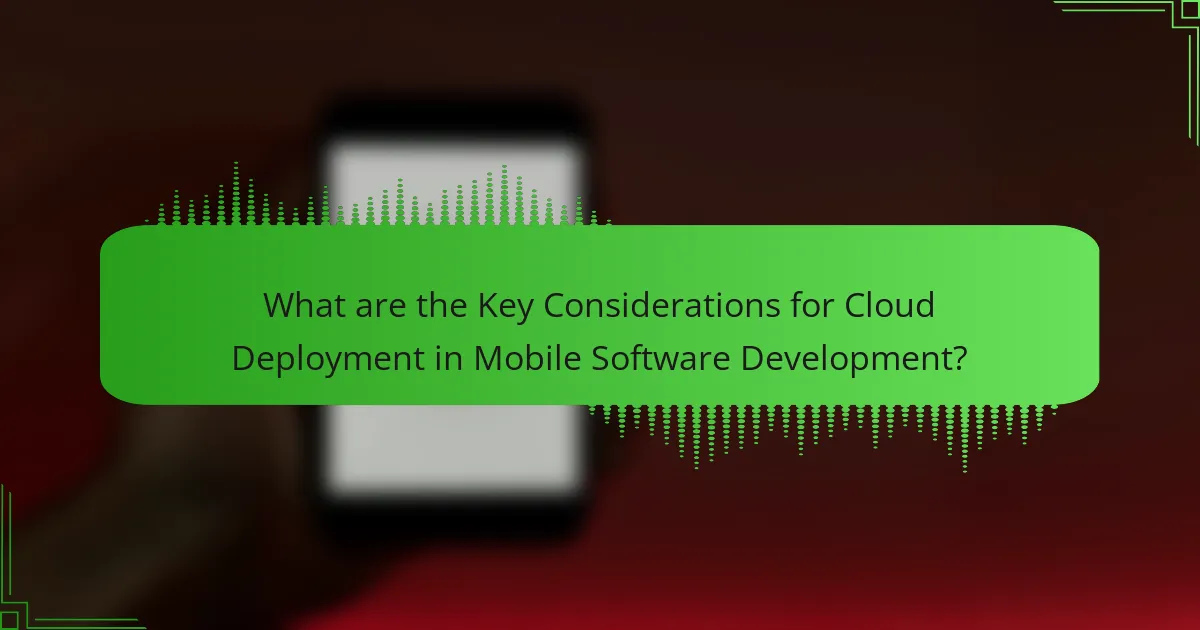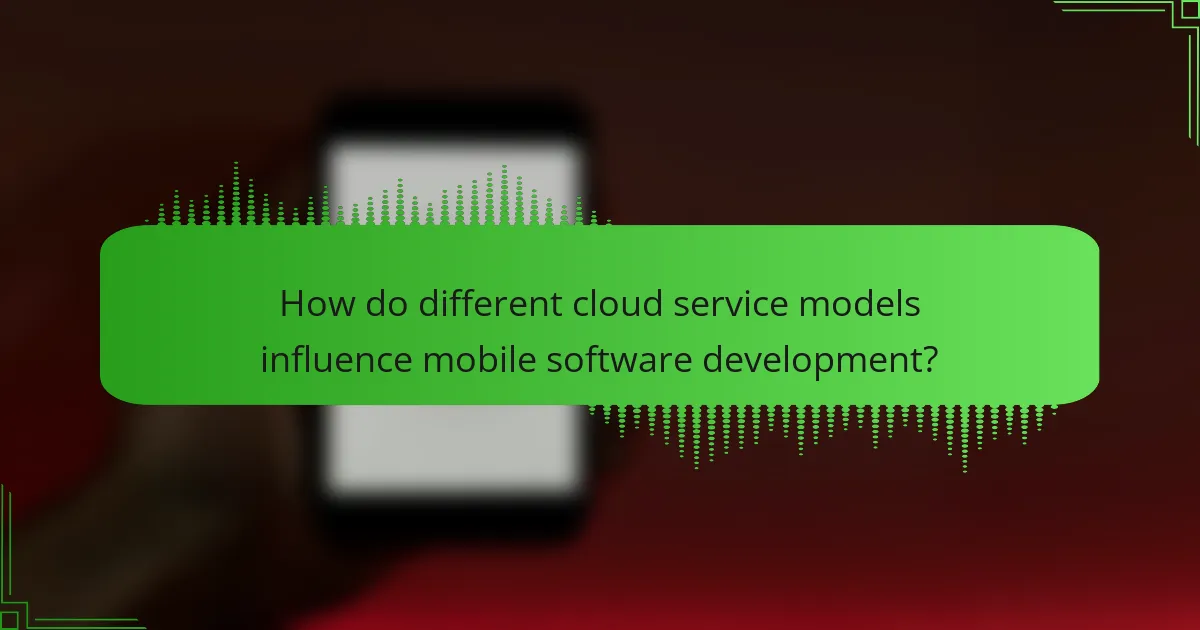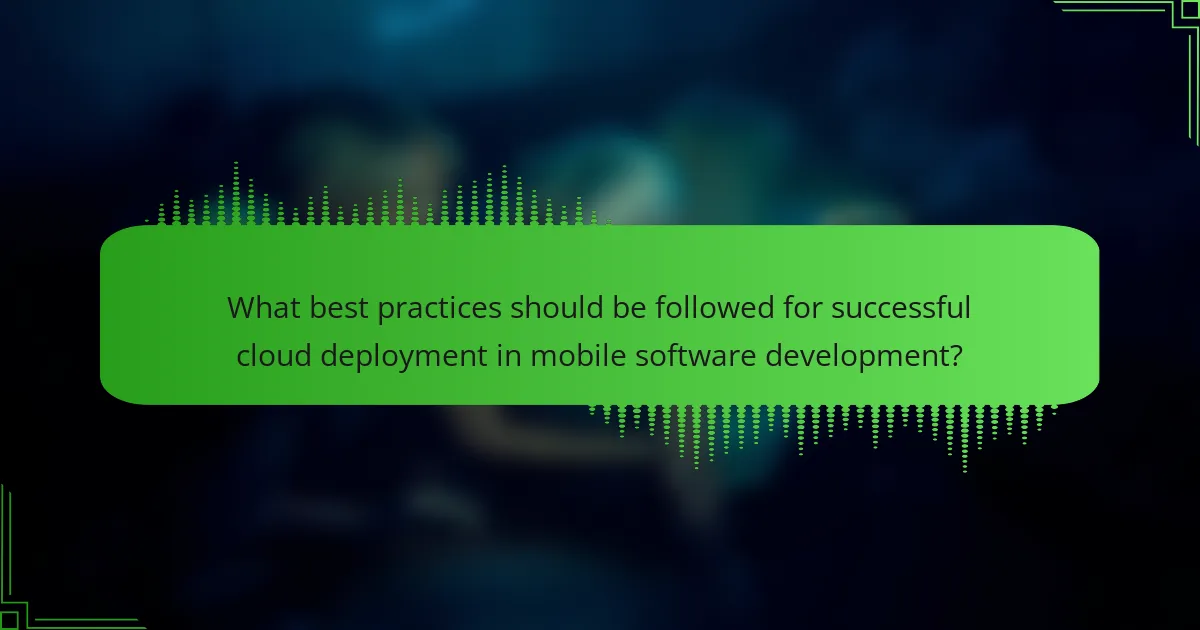Cloud deployment in mobile software development involves critical considerations such as scalability, security, performance, cost management, and integration with existing systems. Scalability ensures applications can efficiently manage varying user loads, while security measures protect sensitive data and support regulatory compliance. The choice of cloud service models—Infrastructure as a Service (IaaS), Platform as a Service (PaaS), and Software as a Service (SaaS)—affects control, flexibility, and resource allocation, influencing overall development costs and scalability. Best practices for successful cloud deployment include implementing robust security protocols, optimizing performance with content delivery networks, utilizing continuous integration and deployment pipelines, and effectively monitoring cloud resources to accommodate user growth and demand fluctuations.

What are the Key Considerations for Cloud Deployment in Mobile Software Development?
Key considerations for cloud deployment in mobile software development include scalability, security, and performance. Scalability allows applications to handle varying loads efficiently. Security measures protect sensitive user data and ensure compliance with regulations. Performance impacts user experience and can be optimized through content delivery networks and load balancing. Additionally, cost management is crucial for maintaining budget efficiency. Integration with existing systems can streamline processes and enhance functionality. Finally, choosing the right cloud provider influences the overall success of deployment. These considerations are vital for effective mobile software development in a cloud environment.
How does cloud deployment impact mobile software development?
Cloud deployment significantly enhances mobile software development by providing scalable resources and flexible infrastructure. It allows developers to access computing power and storage on demand. This reduces the need for extensive local hardware, lowering costs and development time. Cloud services also facilitate easier collaboration among distributed teams. They enable real-time updates and seamless integration of services. Additionally, cloud deployment supports faster deployment cycles. Developers can push updates and new features without extensive downtime. According to a report by Gartner, organizations that leverage cloud infrastructure can achieve up to 30% faster time-to-market for mobile applications. This efficiency is crucial in the competitive mobile app landscape.
What are the essential attributes of cloud deployment in this context?
The essential attributes of cloud deployment in mobile software development include scalability, flexibility, and cost-effectiveness. Scalability allows resources to be adjusted based on demand, facilitating growth without significant infrastructure changes. Flexibility enables developers to choose services that best fit their application needs, adapting quickly to market changes. Cost-effectiveness reduces upfront expenses by utilizing a pay-as-you-go model, allowing businesses to allocate resources efficiently. These attributes collectively enhance the development process, improve user experience, and streamline operations in mobile software projects.
How does cloud deployment enhance scalability and flexibility?
Cloud deployment enhances scalability and flexibility by allowing resources to be adjusted based on demand. This means businesses can easily increase or decrease their computing power, storage, and services as needed. For instance, during peak usage times, cloud services can automatically scale up resources. Conversely, during off-peak times, they can scale down to save costs.
According to a survey by Flexera, 94% of enterprises use cloud services to improve scalability. This adaptability supports rapid deployment of applications and services. Additionally, cloud environments can accommodate varying workloads without requiring extensive hardware changes. This reduces the time and cost associated with scaling infrastructure.
Overall, cloud deployment provides a dynamic solution that aligns with changing business needs.
What challenges are associated with cloud deployment in mobile software development?
Cloud deployment in mobile software development faces several challenges. These challenges include network latency, which can affect app performance. Security concerns arise due to data transmission over the internet. Compliance with regulations can complicate cloud deployment. Additionally, integration with existing systems may pose difficulties. Limited offline capabilities can hinder user experience. Cost management is essential, as cloud services can become expensive. Vendor lock-in can restrict future options for developers. These challenges necessitate careful planning and strategy in cloud deployment.
What security concerns should developers be aware of?
Developers should be aware of data breaches, insecure APIs, and insufficient authentication mechanisms. Data breaches can expose sensitive user information. Insecure APIs may allow unauthorized access to backend services. Insufficient authentication can lead to unauthorized user actions. Additionally, developers must consider insecure data storage and lack of encryption. Insecure data storage can result in data loss or theft. Lack of encryption may leave data vulnerable during transmission. Regular security audits and updates can mitigate these risks. According to a 2021 IBM report, the average cost of a data breach is $4.24 million, highlighting the importance of addressing these concerns.
How can latency issues affect user experience?
Latency issues can significantly degrade user experience. High latency leads to delays in data transmission. This results in slow application response times. Users may experience buffering or lag while interacting with applications. Studies show that a 1-second delay can cause a 7% reduction in conversions. Furthermore, increased latency can lead to user frustration and abandonment. Users expect real-time interactions in mobile applications. If latency is too high, users may switch to competing services. Thus, managing latency is crucial for maintaining user satisfaction and retention.

How do different cloud service models influence mobile software development?
Different cloud service models significantly influence mobile software development by providing various levels of control, flexibility, and resources. Infrastructure as a Service (IaaS) offers developers complete control over the infrastructure. This allows for customized environments tailored to specific application needs. Platform as a Service (PaaS) simplifies development by providing pre-configured platforms, reducing setup time and enabling faster deployment. Software as a Service (SaaS) allows developers to leverage existing applications, focusing on user experience rather than infrastructure management.
Each model impacts cost structure and scalability. IaaS may incur higher costs due to resource management, while PaaS and SaaS often provide predictable pricing models. Scalability is also affected; IaaS allows for extensive scaling options, while PaaS and SaaS offer scalability based on user demand without extensive management.
Overall, the choice of cloud service model shapes the development process, resource allocation, and long-term maintenance strategies for mobile applications.
What are the main types of cloud service models available?
The main types of cloud service models available are Infrastructure as a Service (IaaS), Platform as a Service (PaaS), and Software as a Service (SaaS). IaaS provides virtualized computing resources over the internet. Users can rent servers, storage, and networking. PaaS offers a platform allowing developers to build, deploy, and manage applications without dealing with infrastructure. SaaS delivers software applications over the internet on a subscription basis. These models enable flexibility and scalability in mobile software development.
How do IaaS, PaaS, and SaaS differ in functionality?
IaaS, PaaS, and SaaS differ primarily in the level of management and control they offer. IaaS, or Infrastructure as a Service, provides virtualized computing resources over the internet. Users manage operating systems, applications, and middleware, while the provider handles the hardware. PaaS, or Platform as a Service, offers a platform allowing users to develop, run, and manage applications without dealing with infrastructure complexities. Users focus on application development, while the provider manages the underlying hardware and software. SaaS, or Software as a Service, delivers software applications over the internet. Users access the software via a web browser, with the provider managing everything from infrastructure to application updates. This clear division of responsibilities defines the functionality of each service model.
Which model is most suitable for mobile software development projects?
The Agile model is most suitable for mobile software development projects. This model supports iterative development and rapid feedback. Agile allows teams to adapt to changing requirements quickly. Mobile projects often face evolving user needs and technology trends. Agile facilitates collaboration among cross-functional teams. According to the 2021 State of Agile report, 95% of organizations using Agile reported improved project visibility. This demonstrates its effectiveness in managing mobile development complexities.
What factors should be considered when choosing a cloud provider?
When choosing a cloud provider, consider factors such as reliability, scalability, security, and cost. Reliability ensures minimal downtime and consistent performance. Scalability allows resources to adjust based on demand. Security includes data protection measures and compliance with regulations. Cost involves evaluating pricing models and total cost of ownership. Additionally, assess the provider’s support services and integration capabilities with existing systems. These factors collectively influence the overall effectiveness of cloud deployment in mobile software development.
How do pricing structures vary among cloud providers?
Pricing structures among cloud providers vary significantly based on several factors. Major cloud providers like AWS, Azure, and Google Cloud offer different pricing models. AWS utilizes a pay-as-you-go model, charging based on actual usage of resources. Azure offers both pay-as-you-go and reserved pricing options, allowing for cost savings with long-term commitments. Google Cloud employs a similar pay-as-you-go system but also provides sustained use discounts for long-running workloads.
Additionally, providers may have tiered pricing based on resource consumption. For example, costs can decrease as usage increases, incentivizing higher consumption. Some providers also offer free tiers or credits for new users, which can affect initial costs. Furthermore, pricing can differ based on the region of service, impacting overall expenses. Each provider’s pricing structure reflects their unique service offerings and target markets, leading to varying total costs for similar services.
What level of support and resources do providers offer for mobile development?
Providers offer a substantial level of support and resources for mobile development. This support typically includes comprehensive documentation, SDKs, and APIs. Many providers also offer dedicated technical support teams. These teams assist developers with integration and troubleshooting. Additionally, cloud platforms often provide tutorials and sample projects. They may also host community forums for peer assistance. Some providers offer training programs to enhance developer skills. Overall, the resources available are designed to facilitate efficient mobile app development.

What best practices should be followed for successful cloud deployment in mobile software development?
Successful cloud deployment in mobile software development requires adherence to several best practices. First, ensure robust security measures are in place. This includes data encryption and secure access controls to protect sensitive information. Second, optimize application performance by leveraging cloud resources effectively. This can involve using content delivery networks (CDNs) for faster data access. Third, implement continuous integration and continuous deployment (CI/CD) pipelines. CI/CD practices facilitate rapid updates and improve software quality. Fourth, choose the right cloud service model. This could be Infrastructure as a Service (IaaS), Platform as a Service (PaaS), or Software as a Service (SaaS) based on project needs. Fifth, monitor and manage cloud resources efficiently. Use monitoring tools to track performance and resource usage. Lastly, ensure scalability to accommodate user growth and demand fluctuations. Scalability allows applications to handle increased loads seamlessly. Following these best practices enhances the effectiveness of cloud deployment in mobile software development.
How can developers ensure effective integration with cloud services?
Developers can ensure effective integration with cloud services by utilizing standardized APIs and protocols. These tools facilitate seamless communication between applications and cloud platforms. Additionally, developers should prioritize security measures, such as encryption and authentication, to protect data during transmission. Implementing robust error handling and logging mechanisms is also essential. This allows developers to quickly identify and resolve issues that may arise during integration. Furthermore, thorough testing in various environments ensures compatibility and performance. According to a report by Gartner, 85% of organizations using cloud services reported improved operational efficiency. This statistic highlights the importance of effective integration in achieving desired outcomes.
What tools and frameworks facilitate cloud integration?
Tools and frameworks that facilitate cloud integration include API management platforms, integration platforms as a service (iPaaS), and cloud service providers’ native tools. API management platforms like Apigee and MuleSoft streamline the creation, deployment, and management of APIs. iPaaS solutions such as Dell Boomi and Zapier enable seamless data integration across cloud applications. Additionally, cloud service providers like AWS, Azure, and Google Cloud offer native integration tools that simplify connecting various services. These tools enhance interoperability and streamline workflows, making cloud integration more efficient.
How can continuous testing and deployment improve outcomes?
Continuous testing and deployment enhance outcomes by ensuring software quality and reducing time to market. This approach allows for immediate feedback on code changes. It helps identify defects early in the development process. Early detection reduces the cost of fixing bugs significantly. According to the 2020 State of DevOps Report, high-performing teams deploy 200 times more frequently than low performers. Continuous testing also supports better collaboration among team members. Enhanced collaboration leads to more innovative solutions. Overall, these practices lead to improved customer satisfaction and product reliability.
What are common troubleshooting strategies for cloud deployment issues?
Common troubleshooting strategies for cloud deployment issues include checking configuration settings, monitoring system logs, and verifying network connectivity. Configuration settings should match the cloud provider’s requirements. Monitoring system logs can reveal error messages and performance bottlenecks. Verifying network connectivity ensures that all components can communicate effectively. Additionally, testing deployment scripts can identify issues before going live. Using cloud provider support resources can provide specific guidance tailored to the platform. Implementing automated monitoring tools can also help detect issues early. Regularly updating documentation aids in resolving recurring problems efficiently.
How can developers quickly identify and resolve performance bottlenecks?
Developers can quickly identify and resolve performance bottlenecks by utilizing profiling tools and monitoring metrics. Profiling tools, such as CPU and memory profilers, help pinpoint resource-intensive areas in the code. Monitoring metrics like response time and throughput provides insights into performance issues.
By analyzing these metrics, developers can identify slow database queries or inefficient algorithms. Additionally, employing logging frameworks can help track application performance over time. Regularly reviewing logs allows for early detection of anomalies.
According to a study by Microsoft, using performance monitoring tools can reduce troubleshooting time by up to 50%. This demonstrates the effectiveness of systematic monitoring in addressing performance bottlenecks.
What resources are available for ongoing support and learning?
Resources for ongoing support and learning in cloud deployment for mobile software development include online courses, documentation, and community forums. Online platforms like Coursera and Udemy offer courses specifically on cloud technologies. Official documentation from cloud providers such as AWS, Google Cloud, and Microsoft Azure provides in-depth technical guidance. Community forums like Stack Overflow and GitHub allow developers to ask questions and share solutions. Additionally, webinars and workshops hosted by industry experts offer practical insights and updates on best practices. These resources ensure developers stay informed and skilled in cloud deployment strategies.
The primary entity of this article is cloud deployment in mobile software development. Key considerations include scalability, security, performance, and cost management, which are crucial for effective application development in a cloud environment. The article outlines how cloud deployment enhances flexibility and supports faster development cycles while addressing challenges such as network latency and security concerns. It also discusses different cloud service models (IaaS, PaaS, SaaS) and offers best practices for successful integration and ongoing support in mobile software projects.


